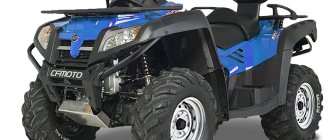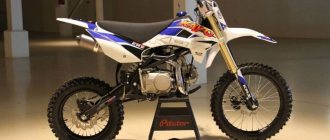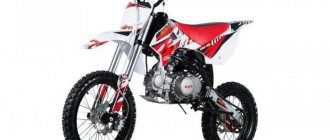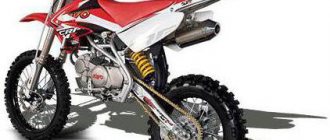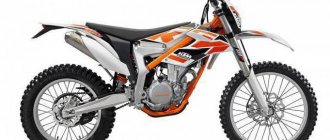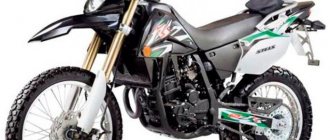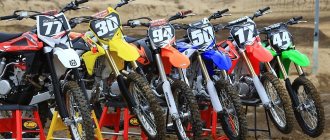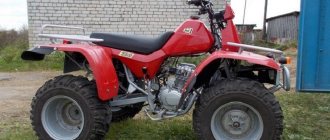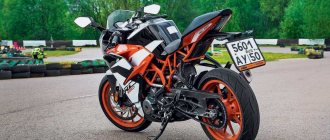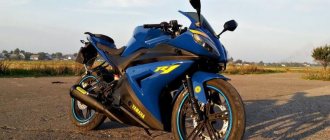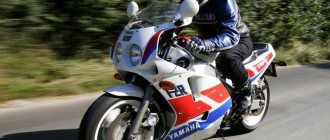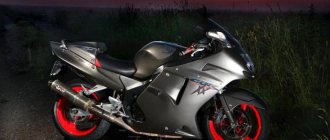The decision to buy a Kayo ATV is without a doubt the right one. This brand produces models with different technical characteristics, which allows each customer to choose the best option according to their preferences. ATV manufacturer Kayo has been on the motorcycle market for a long time. Over the years of its work, the company has managed to take a leading position in this direction. Its ATVs are known for their high cross-country ability and maintainability.
Kayo was founded in 1999 in China. The products immediately became in demand due to their affordable price and acceptable quality. At first, the company was engaged in the production of cross-country motorcycles, which were developed jointly with Italian designers. Since 2000, the manufacturer Kayo has entered the global market, supplying its products to many countries.
Gradually expanding its range, the Chinese manufacturer began producing Kayo ATVs. Today, the lineup includes many all-terrain vehicles that are designed for children and adults. A wide range of equipment allows you to choose the appropriate option.
Nowadays, Kayo is constantly improving its motorcycle technology. More than 15 thousand ATVs are produced annually. The model range is constantly updated, which allows us to fully satisfy the growing demands of customers.
Features of Kayo ATVs
Kayo ATVs are distinguished by their impressive design and high build quality. Every year the technical characteristics of motorcycles are improving, which pleases fans of riding all-terrain vehicles. At the same time, the cost of ATVs from the Chinese brand remains affordable.
Kayo four-wheelers belong to the class of all-terrain vehicles and fully comply with all its parameters. A distinctive feature of the brand’s cars is the presence of disc brakes on both the front and rear wheels. Also, all ATVs are equipped with a CDI electronic ignition system and electric starters.
The model range is varied. There are ATVs for beginners and experienced riders.
Kayo ATV: model range
The Kayo company produces many models of ATVs. The most popular in our country are:
- Bull The model is air-cooled and has a semi-automatic transmission with reverse function. The cost of the device is 66.5 thousand rubles.
- Bull 150 The device is equipped with a four-stroke single-cylinder engine with oil-air cooling, as well as an electric and manual starter. The price of the car is 106 thousand rubles.
- Predator The model has an automatic transmission (variator) and a four-stroke single-cylinder air-cooled engine. The cost of the device is 66.5 thousand rubles.
- Space-1 KD The manufacturer installed air cooling and an automatic transmission (variator). The price of this Chinese car is 54 thousand rubles.
- Storm This is a model with a four-stroke single-cylinder engine and an air cooling system. The car has a semi-automatic transmission with a reverse function. The modification price is 106 thousand rubles.
Kayo T2 250 Enduro repair
I have never encountered Chinese motorcycles. Just heard the reviews. Let's try... I'll make a reservation right away in the topic: we will not describe the full repair cycle, we will touch on the most interesting points.
I got my hands on a Kayo T2 250 Enduro motorcycle. The owners poured 95 gasoline into it. At one point it stalled and would not start again.
We measured the compression, the device showed 0. The analysis process is quite exciting. At each stage, a surprise awaited us in the form of different sized bolts or nuts. But surprisingly everything came off easily. If my memory serves me correctly, its mileage is about 4-5 thousand km. When it comes to hexagon socket bolts or Phillips screws, you begin to feel the softness of the metal.
One person is able to remove the engine from the frame, and even put it back. True, you need to be physically developed.
In order not to have to worry about setting marks later, I recommend immediately finding the top dead center and using a core to mark the mark on the sprocket and camshaft. When it comes to dismantling the timing belt, the star will have to be unscrewed, but it can be installed on either side of the shaft.
We remove the head, and then lift the cylinder and see a beautiful picture.
There are pieces on the piston, on one side it is flattened and the rings are pinched so that they cannot be removed from the grooves. There are serious scuffs on the cylinder head.
Moreover, one of the valves is bent. The bent valve seat was practically undamaged. True, it took much longer to grind in than the whole valve.
After grinding in, we checked the tightness just in case.
It was not possible to buy the necessary spare parts the first time. I had to take samples. Believe it or not, even Chinese spare parts from KAYO have non-original ones. Spare parts have been purchased, let's try to compare the cylinder and piston.
The cylinders are a little different, what surprised me most was the honing of the new one, it was clearly done by hand, and the color of the metal was suspicious. On the old cylinder, the honing was done better. (unfortunately the photo was not clear, I saw this 2 weeks after the completion of the repair)
Let's compare the pistons. On the new piston, the cast numbers are not clear, but on the old one everything is perfectly legible.
There is nowhere to go, we will continue to collect, I hope that the resource of the cylinder and piston will last for a long time. Before the engine is installed in the frame, it is better to immediately adjust the valve clearances. Since the technological windows for adjustment are specific, the standard probe had to be bent 90 degrees. Frankly speaking, I was sorry to spoil the tool, so I had to buy another set of probes.
Assembling a motorcycle is no less exciting than disassembling it. Especially after you place the internal combustion engine in the frame and begin to match the engine mounting brackets located on the frame with the holes in the engine. Having installed the bolts in one place, you realize that they don’t want to be installed in another. And so it is almost everywhere. Although there were no such problems in the engine. I will not describe the conclusions. I suggest you do this based on the photo below. Hint: Look for two extra “items” inside the dashboard.
Specifications
The Chinese company's product range includes devices for children, teenagers and adults. Each model has its own strengths and weaknesses. The buyer will be able to find cars with:
- Engine 4-25 liters. With.
- Engine volume – 71-250 cm³.
- Disc brakes.
- Automatic and semi-automatic transmission.
Depending on the technical characteristics, Kayo ATVs can move on different surfaces. This can be asphalt, primer, as well as loose and dirty soil, wetlands, sand, etc.
Good afternoon bikepost! At the moment, the odometer shows almost a thousand kilometers off-road, country roads and a little on asphalt, which means it’s time to tell you what happened to the Chinese enduro motorcycle during this time. Details under the cut)
In general, the motorcycle continues to give pleasant emotions. Over almost a thousand kilometers, the following happened:
1. In the last post I mentioned a broken clutch lever 2. A broken electric starter start lever was also mentioned there 3. When I fell, I bent the support pad of the brake pad, it was not possible to bend it to the “factory” geometry, but since it was later replaced with screws. 4. During the same fall, I bent both rear-view mirrors, ordered folding ones, let’s see how long they will last (since I have a license and a title, and I’m driving to the place on my own without them) 5. After incorrect installation of the lever protection, the wiring burned out
Here's more about this:
After the motorcycle fell out of the blue due to the side support not being fully positioned, I bought universal lever protection from SM Parts. Spoiler - I categorically do not recommend it for this motorcycle). The problem is the following - the mount practically rests on a bundle of two wires coming out of the brake machine. During installation twisting this way and that, a position was found in which they were not touching, but the gap was symbolic. We took it for a ride, everything was fine. In a couple of days I’m getting ready to go, I turn the ignition key - zero reaction. As it turns out, the fuse is blown, which surprised me: I drove into the garage with my moving, the motorcycle stood motionless for two days and this is the situation. I changed it and drove off. Somewhere after a couple of hours of riding, the motorcycle suddenly stalls on the move, the dashboard starts flashing wildly. I start to slow down while turning off the ignition and notice that smoke is starting to come from under the tidy. I jump up. from the motorcycle - a flame is already blazing cheerfully on the central harness. It’s good that we managed to extinguish it immediately with a banal clap of our palm. As a result, we go on a cable to the garage to figure out what’s wrong, the day off is ruined). As it turned out, the hand protection fasteners began to fray the “frog” flagellum from the brake machine and because of this the fuse burned out for the first time. During the above-mentioned ride, he completely frayed it - the result is natural.
Since I have a fresh 20-year-old motorcycle, wiring specifically for my motorcycle is not on sale. In the store (the rules seem to prohibit mentioning names and addresses) they offered wiring from T2G to order, since from T2\T4 it is sold in the sports equipment version and is definitely not It fits, too, from the older T2 Super. I waited about 2 weeks, unfortunately, the T2G didn’t fit either. I wrote to the officials and didn’t get a response. I contacted several stores, but it didn’t add any clarity to when it would appear. Another week later I got back to you We contacted the first store and said that the item appeared in the suppliers’ price lists, but delivery would be in a month at best. A month and a half passed, but it still wasn’t there and it’s still not clear when it will be available. Here you have the Chinese, for which they sell spare parts on every corner It is worth mentioning that I live in a rural regional center and we have two and a half (figuratively) self-taught auto electricians in the entire region who flatly refused to restore the burnt harness. I started calling people in two cities nearby to take on the restoration without a diagram (there is one Few people want to buy an old T2 with a different engine and with errors. Those who are ready to take it (and there are not many of them) are simply asking for an outrageous price tag, citing the fact that for the time spent (until you figure out what goes where where, there is no diagram, the sheath of some wires has melted, It’s not clear what colors were there) they will earn a lot more from their specialized work as an auto electrician than I’m ready to offer. Then, as it turned out, one of my friends with whom I haven’t talked for a long time works with VAGs and just on wiring. In two days and an unfortunate thousand rubles, he assembled a scythe again from VAG wiring. Now we can say that I have German wiring in my Chinese motorcycle). Thank you Lekha! Well, at least this significant part of the motorcycle season did not pass me by, I rode a pit bike that a friend from another city keeps in my garage. I was afraid that there might be problems with the ignition coil, the ignition itself, the switch, the charging relay... But everything worked out, after installing the harness on the motorcycle started up in its rightful place, as they say, with half a turn. The only thing that was missing was the turn relay, but since it’s cheap and universal, it doesn’t matter. That’s the story.
6. Chain for 1000 km. stretched almost to critical values, but with it, in general, everything was clear from the beginning) 7. The explosive wire on the spark plug melted (I routed the wire incorrectly when I changed the wiring) 8. The right rear turn signal was broken, how and when it is not clear)
In general, all problems are caused by falls and incorrect installation of lever protection. It’s a shame, of course, but as they say, it’s your own fault. The motorcycle starts with half a turn, rides properly and continues to delight me with bright emotions.
Briefly about the plans:
1. Folding mirrors (they've been on their way from China for a month and a half now) 2. Pro Taper grips (installed) 3. Replacing the chain with a sealless DID 4. Replacing the gearbox foot with a slightly longer one (with mine it's not very convenient in motorcycle boots, the foot is already on the way) 5 Replacement of the brake pad support pad with a slightly wider one (on the road with the pad) 6. Replacement of rear turn signals (with running stripe) 7. Folding arms and steering wheel weights 8. Stud the tires for the winter and buy a second set for the summer 9. Finally put the motorcycle on accounting)
Thank you for reading) If anyone is interested in following this motorcycle on Instagram, you can find me under the nickname Hellthrasher.mgn. See you in the next posts!
Operating experience
Owners of Kayo equipment note its reliability and durability. If handled properly, the company's ATV will last 3-5 years, after which the engine life will be exhausted.
Before purchasing, you should immediately decide for what purpose the ATV is needed. If the device will be used only for recreation and driving on flat roads, it is recommended to purchase an all-terrain vehicle with a 110 cm³ engine. But for more serious tasks, it is better to choose models with a more powerful engine.
Almost all ATV models of the Chinese brand are utilitarian. This is a universal technique that can be used for walking, fishing or hunting trips, transporting and towing cargo. Also, ATVs with a powerful engine are capable of performing various household tasks in the garden or field.
Owner reviews
When driving, four-wheelers reach a speed of about 60-65 km/h (depending on the model). This is quite enough to feel the thrill of driving.
The engines of all all-terrain vehicle models are economical. They can work for a long time, maintaining their characteristics even under conditions of increased load. Gasoline consumption for vehicles with a 100 cc engine, depending on driving conditions, ranges from 3.5 to 5 liters per 100 km.
ATVs are lightweight, maneuverable, but at the same time stable. Children's and adult models differ not only in size and engine power, but also in the size of the fuel tank. For children's equipment, the gas tank capacity ranges from 2 to 5. ATVs for adults are equipped with a fuel tank with a capacity of 5 liters or more. Considering the cost-effectiveness of the technology, this is quite enough for long-distance travel.
Test drive Kayo125 WildCat, Kayo140 CraZyCat, Kayo150 VorteXCat
Pit bikes, which have become incredibly widespread abroad, are for some reason considered an “unseen animal” in the vastness of our homeland. This technique is a smaller copy of a cross bike, which is equally convenient for both children and adults. The scope of application of pit bikes is extremely diverse: motocross, stunt riding, supermoto and enduro. Well, let's meet three representatives of this class.
My first acquaintance with this technique took place via the Internet. Looking at the nice photographs of this “miracle”, I still had little idea of the dimensions of the pit bike, and even more so, its behavior under the yoke of the 85-kilogram “carcass” of the tester. However, interest was born even then.
I was able to test three models of the same brand: Kayo 125 WildCat, Kayo 140 CraZyCat and Kayo 150 VorteXCat. As the names suggest, they have engines of 125, 140 and 150 cubic centimeters, respectively. Actually, this is their main difference, because the chassis of pit bikes is almost the same.
They are based on a spatial tubular steel frame with a very decent quality of welds and a competent design (probably copied from European pit bikes). The front suspension is an adjustable (!) upside-down fork, and at the rear there is a cast aluminum swingarm, which is supported by a monoshock absorber. The latter, by the way, has an adjusting washer for adjusting the preload of the spring. In addition, pit bikes come standard with brake, clutch and gearbox levers that fold when dropped, which significantly extends their service life in conditions of frequent falls. “Pleasant little things” also include thick white vinyl stickers on the plastic, which are located in places where there is likely to be contact with the “underlying surface,” silicone steering wheel grips and a valve cap on the gas tank cover, which prevents gasoline from leaking out during falls.
I decided to start with the younger, 125 cc model. Contrary to my fears, the pit bike started from the very first push of the kickstarter. Wow, the sound is clearly not relative to the engine size. Not constrained by legislative standards for noise and exhaust toxicity, the Chinese bolted a direct-flow exhaust system onto the pit bike! That’s why this “octagon” sounds no worse than a cross-country 450 (adjusted for decibels).
Sitting behind the wheel, I felt quite at ease. The ergonomics of the driver's seat are clearly designed for an adult, as is clearly demonstrated by the seat height, which is 835 mm!
I squeeze the clutch, press the gearshift foot... and stand still. It turned out that the gears on these pit bikes are switched according to the N-1-2-3-4 pattern (instead of the usual 1-N-2-3-4). I would not call such a technical solution successful. Just imagine: you approach a corner of a cross-country track at good speed, shift down gears, but miss the first gear, ending up in neutral. As a result, instead of sharp acceleration after the apex and a fountain of earth from under the rear wheel, the pit bike only “idles” scares the area with a loud roar. In addition, “catching neutral” in a static position on the Kayo 125 is an activity for puzzle lovers. Well, that’s why it’s the cheapest in the series.
So, having more or less figured out the checkpoint, I started. The first gear seemed too short to me, but on reflection, I decided that this was still a plus. With such a gear ratio, even a motor that is not related to Hercules can develop decent traction. For example, in order to drag an 85-kilogram pilot up a long steep slope.
Having escaped into the “operational space,” I unscrewed the gas handle and, clicking through the gears, began to accelerate.
Two-valve four-stroke engine that produces 8.3 hp. at 7500 rpm, it demonstrates good torque at low and medium speeds, but is “specifically blunt” at the “top”. Therefore, I didn’t want to experiment with maximum speed (and even on icy primers). Despite its small size, the pit bike accelerates quite quickly, but you can guess for yourself what the consequences of falling off-road, and even at a speed of about 50-60 km/h, are.
The pendant left a pleasant impression. Frankly, at first I thought that it served a purely decorative function here, but the front fork and rear monoshock absorber turned out to be fully functional! Their energy intensity is enough to withstand impressive jumps or rush along the “washboard” without slowing down at the “cruising” speed of 50-60 km/h. And for off-road use this is a lot. In any case, much more than 120 on asphalt. However, it was not without its drawbacks. In contrast to the well-functioning front fork (adjusted for the oil thickening due to cold weather), the rear suspension works “so-so”, as a result of which the pilot sometimes does not understand what is happening with the rear wheel.
But the hydraulic brakes do not cause any complaints. For a 71-kilogram device with a “maximum speed” of 80 km/h, their efficiency is enough “for the eyes.” However, if you put a set of light-alloy road wheels on a pit bike and put them on slicks, then even in this case the performance of the standard braking system of the newly-minted minimotard will be more than enough.
Leaving the 125 to cool down to the sound of the clicking air vent, I switched to the 140 cc model. This pit bike has a slightly different frame design, different forms of plastic lining and a creative white and green coloring. By the way, the plastic on all three models turned out to be “correct”. It is soft and very flexible, that is, it does not break when dropped.
CraZyCat is 20 mm shorter and the same 20 mm lower than its brothers, but this difference remains only on paper. Looking ahead, I will say that while driving I did not notice any differences between them in ergonomics and handling. The Kayo 140 engine is another clone of the Honda Super Cub engine. This power unit produces almost 10 hp. at 8000 rpm, and is therefore equipped with an oil cooler.
Despite my remaining doubts, the engine also started on the first “kick”, filling the surrounding area with a deep roar. Having clicked the gearshift foot in a static state, I was surprised to find that all gears were switched clearly, and neutral was caught “on time”.
Thanks to the short first gear, careless handling of the throttle can result in the Kayo 140 CraZyCat getting into a wheelie, or even throwing off the slob pilot. Well, let's take it into account. Due to the faster engine and clear gearbox, this pit bike is perfect for all sorts of reckless activities. As I circled around the area, I dreamed of going to an indoor BMX park. It was there, on trampolines of various configurations, that one could have a real blast.
The 140 cc power unit works, how shall I put it... more expressively than the “125”. It follows the throttle better and has more impressive traction throughout the entire rev range.
Having ridden the Kayo 140 to my heart's content, I switched to the 150 cc VorteXCat, which, with the exception of the engine, is a copy of the 125 cc WildCat. But when designing the motor, the designers did not limit themselves to simply increasing the working volume. They also increased the compression ratio, thanks to which the engine began to produce 13.6 hp. at 9500 rpm, and 11.2 Nm at 7500 rpm. And if you also remember that the dry weight of the pit bike remained at 71 kg, then you can guess that the Kayo 150 will “make” the same Yamaha YBR-125 and other road motorcycles of similar cubic capacity from the start. As expected, the engine started easily. This pit bike has an even sharper exhaust “voice” than its “younger” brothers. Well, let's see how he is in business.
I engage first gear, release the clutch and... gas, gas! The pit bike rushed forward, throwing out a fountain of melted snow and dead grass from under the rear wheel. The Kayo 150 motor is even more playful and spins up faster. Perhaps this device comes closest to KTM minicross motorcycles and Polini pit bikes. The positive impression of the engine is enhanced by a clearly operating gearbox with a well-catched neutral. Due to the higher degree of compression, the power unit has lost a little in elasticity compared to the 140 cc model, but at the “top” it shows a more evil disposition.
The controllability of all three fully deserves the epithet “bicycle-like” - Kayo is able to turn around on a spot with a diameter of just over a meter, and literally the power of thought is enough to change the trajectory. When I put the pit bike into a power drift to the delight of the photographer, I felt unprecedented confidence. Thanks to its low weight and low seat height, a pit bike will forgive many piloting mistakes, and maybe even teach you something. Apparently, it’s not for nothing that “bourgeois” motorcycle schools begin teaching the art of stunt riding with just such a technique.
I believe that if pit bikes could be adapted for use on public roads, they would become a bestseller among active, uncomplicated youth. Having a low cost, light weight, a peppy engine and excellent handling, such devices would be an excellent alternative to other urban transport.
However, even under the current situation, such devices are an excellent means for active recreation and amateur motorsports.
Completing the test drive, I was finally able to unequivocally answer the traditional question: “would you like to see such equipment in your garage?” So as I write this, the white and green Kayo 140 CraZyCat is preparing to take pride of place in the pit next to my KTM 990 Adventure.
Text: Sergey Kuznetsov
Photo: Andrey Shlenchak
Test equipment provided by:
Mototech.Kiev.Ua
Kiev-Svyatoshinsky district, village. Gurovshchina
(Kyiv-Zhitomir highway, 31st kilometer)
Repair and tuning
Users note the high build quality of Kayo ATVs. Therefore, after purchasing the car, the owner will not need to change parts. The buyer only needs to break in the all-terrain vehicle in accordance with the manufacturer's instructions. Next, the user will need to change the oil and undergo periodic maintenance.
Some ATV owners increase engine power, which allows them to reach speeds of up to 100 km/h. You can also additionally install protection, rear view optics, side lights, GPS navigator and other systems. They will increase the functionality of the vehicle and improve ride comfort.
